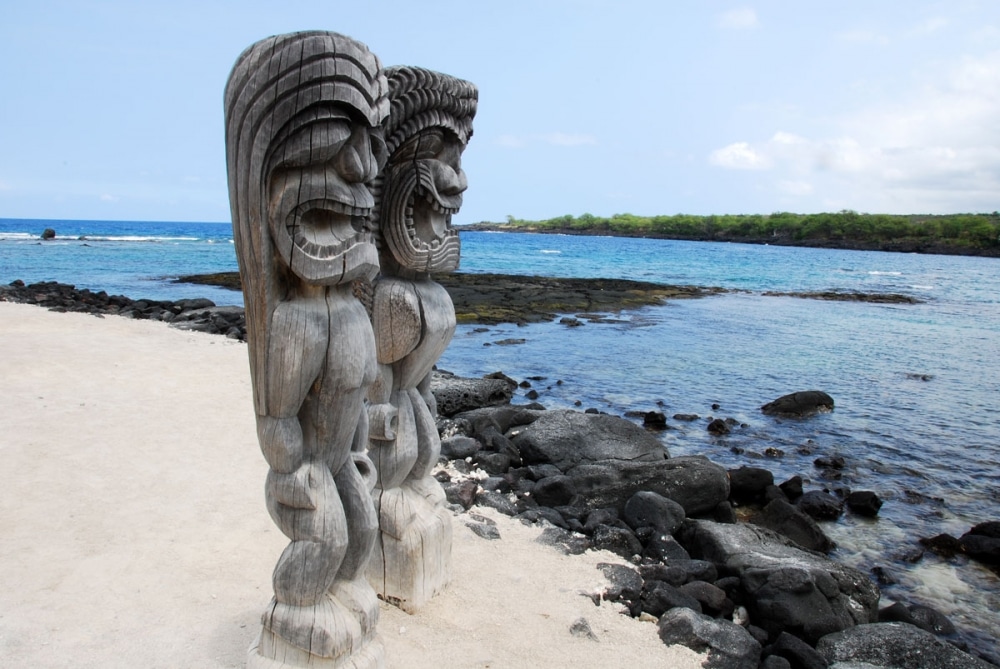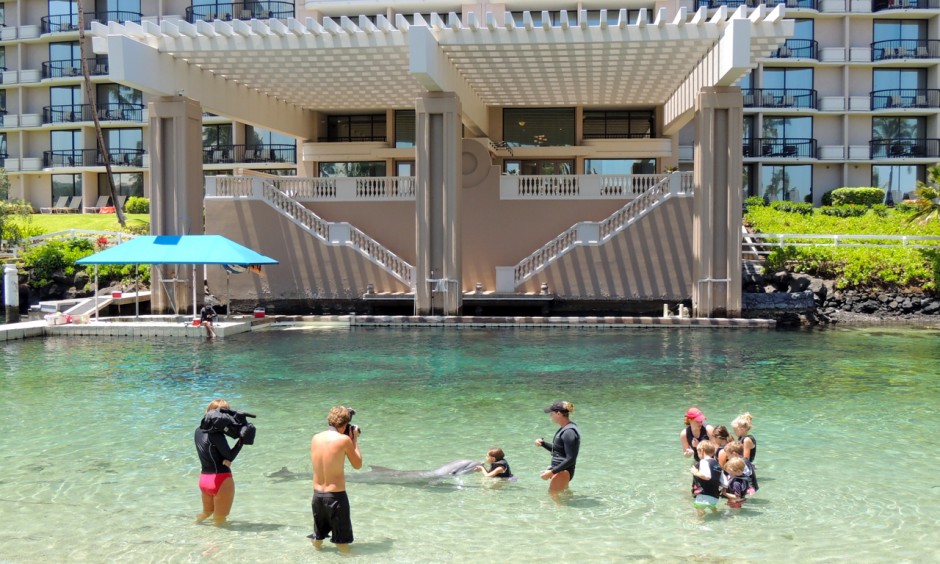When we were considering a move to Hawai’i, I looked at a map and was surprised to see how isolated these islands are, a few specks in the middle of the Pacific Ocean. I wondered what they were like and how humans came to find such remote lands. Once we arrived on the Big Island, we began to explore, haphazardly at first and then with more purpose, and to read as much as we could about what we were seeing.
There are innumerable signs of the presence of the original inhabitants. Stone structures, some well-preserved and others just remnants of walls, dwellings, and burial sites, are everywhere. We have seen thousands of petroglyphs, pecked laboriously into the lava. Along the western coast, we have marveled at large spring-fed fish ponds, which the Hawai’ians connected to the sea in such a way that small fish could get into them but as they grew larger could not escape. Toward the mountains we have seen faint traces of what were terraced fields on which farmers grew sweet potatoes and taro.
The descendants of those who discovered Hawai’i have been badly treated. When the Europeans and Americans arrived, first Captain James Cook in 1778 and then waves of businessmen and missionaries, multitudes succumbed to disease, so devastated within a few decades that, despite the best efforts of the kings and chiefs, they were unable to prevent the theft of their lands, the destruction of their fields, and the exploitation of their fertile soils for the production of sugar and pineapples. There are other reasons, of course, for what happened—the superior armaments of the Europeans and Americans, naïve collaborations** between Hawai’ian royalty and foreigners. However, the precipitous decline in the native population, similar to that in Latin America, is so often neglected by historians that it deserves to be placed front and center as a causal factor.
Still, the Hawai’ians survived, and some of them continued to resist social annihilation. As early as the middle of the nineteenth century, Hawai’ians in service to the royal courts learned to read and wrote the elaborate oral histories that had been learned and handed down for centuries. These have proved invaluable to both scholars and future generations of Hawai’ians intent on keeping their culture flourishing. Always, too, there has been a current of nationalism, a desire to be free of the curse of colonization and to regain independence. In the 1960s and ‘70s, a wave of political and cultural nationalism swept the islands and is still alive today.
One of the achievements of all of these currents and agitations has been the gradual demolition of the worldview of the colonizers and imperialists who have told us that the aboriginal people were backward, not progressive in their thinking. That, in effect, their conquerors did them a favor by “civilizing” them. Native anthropologists, archaeologists, folklorists, and historians, as well as non-native but sympathetic researchers, have proven conclusively that those who first settled the islands were people of consummate skills and intelligence.
The archaeological evidence tells us that Hawai’i was discovered by Polynesians from Tahiti about 1,000 years ago. Tahiti is approximately 2,600 miles almost due south of Hawai’i. How could “primitive” humans, without modern seafaring equipment and no knowledge of science, have made the journey? Some have believed that the discovery of the islands was fortuitous, the result of storm-tossed boats drifting ashore. However, the oral histories tell us the voyages made by the Polynesians were purposeful, and contemporary recreations of such a journey show that it could have been done.
Today, it is almost certain that the Polynesians who found the Hawai’ian islands were incredible navigators. Using the outrigger canoe technology invented by their seafaring ancestors from southern China, they moved across the Pacific settling the far-flung lands of the great ocean. They even made it as far as South America. One writer described their remarkable skills:
While Europeans were making short, stuttering voyages, navigating by dead reckoning with a compass or by keeping shoreline landmarks in sight by day, Polynesians voyaged out of sight of land for weeks at a time, navigating by the detailed knowledge of the patterns of star motions, tides, winds, changing ocean currents, migration patterns of animals, knowledge of how clouds might characteristically congregate over a certain island, weather patterns and the changes in the color of the sea. Their system of navigation kept track of the way those patterns changed in relation to each-other and with changing latitude and longitude, map concepts of which they had no knowledge.
They knew intimately the interference patterns of large-scale wave-sets across the ocean and used them as a sort of Cartesian Coordinate system to plot their course. A Polynesian navigator could tell by the shape of a mid-ocean wave whether or not it had crested an island in the past 2 weeks.
We saw indirect evidence of this on the north coast of the Big Island, along a rail-to-trails path near what had once been a sugar mill. Atop a small hill of grass and rocks, there is a heiau (a temple, of which there are many types) that marks the navigational prowess of the Polynesian sailors. The heiau consists of large chiseled lava stone markers pointing out to sea. Scientists have shown, using GPS technology, that each aims accurately to a distant island, one toward Tahiti, another the Marquesas, and others toward islands that the Polynesians had settled. Had Hawai’i’s original settlers drifted at sea and struck land by chance, the navigational heiau would not exist.
Direct proof that the Polynesians were purposeful sailors came in 1976. A double-hulled sailing canoe was built on O’ahu through the efforts of the Polynesian Voyaging Society in the hope that it could be sailed without modern instruments to Tahiti. It was named Hōkūleʻa, Hawai’ian for “star of gladness,” in reference to the star Arcturus, which helps navigators locate the islands. Because no Hawai’ians at that time possessed the ancient knowledge, the Society persuaded a master Micronesian navigator “Mau” Piailug to lead the voyage and train Hawai’ians in his craft. He did so, setting sail from Maui on May 1, 1976 and landing in Tahiti on June 4. 17,000 people greeted the crew, half of Tahiti’s population. The sailing genius of the Polynesians was established once and for all. Interestingly, this voyage gave a tremendous impetus to the cultural reawakening then taking place in Hawai’i and helped spur similar rebirths throughout the Pacific islands.
The navigational heiau and the other traces we have seen of what the ancient Hawai’ians built have inspired us and made us feel that a great deal must have been lost when their world disappeared. Our inspiration and intuition were well-founded. Both historical and archaeological research have demonstrated that the ancient Hawai’ians had a complex culture, with sophisticated agriculture and aquaculture, vibrant oral history, beautiful artistic representations, ingenious construction techniques, exceptional sanitation, and a well-developed social division of labor. Further, an archaic state developed autonomously, similar to ones built in Egypt, along the Tigris and Euphrates, and in various parts of what is now Latin America. The most remarkable thing of all is that the original inhabitants built an intricate political economy in total isolation from the rest of the world. While workers in England were starving in filthy cities and laboring in “dark Satanic” mills, while children as young as four were working in coal mines, where life was “nasty, brutish, and short,” Hawai’ians were almost certainly living healthier, cleaner, and more meaningful lives. And just as surely, they were not befouling and destroying the nature that gives all of us sustenance.
The emotions that Hawai’i has provoked in us are similar to those we have experienced in the mainland’s southwest. We have sensed the presence of the earliest natives and today’s American Indians. We have felt rage that the reckless and ceaseless pursuit of money has wreaked such mayhem on them. We have suffered guilt because some of our ancestors may have been responsible for this. We have been angry that people today don’t much care about what happened in the past and feel no need to try to make amends. And we have wondered how it is that so few of us think anything can be learned from the wisdom of those who came before us. What they left behind speaks to us. We just need to listen.
*Slightly edited version of an essay that first appeared in Counterpunch, Jan. 1, 2015.
** A reader pointed out that naive was too gentle a word to use here. The Hawai’ian kings made deals with the English, for example timber for guns, which aided them in wars with their island rivals but also generated great hardship for the common people, whose hard labor provided the lumber. By the time Captain Cook arrived on the scene, Hawai’i had become a rigid class society.










